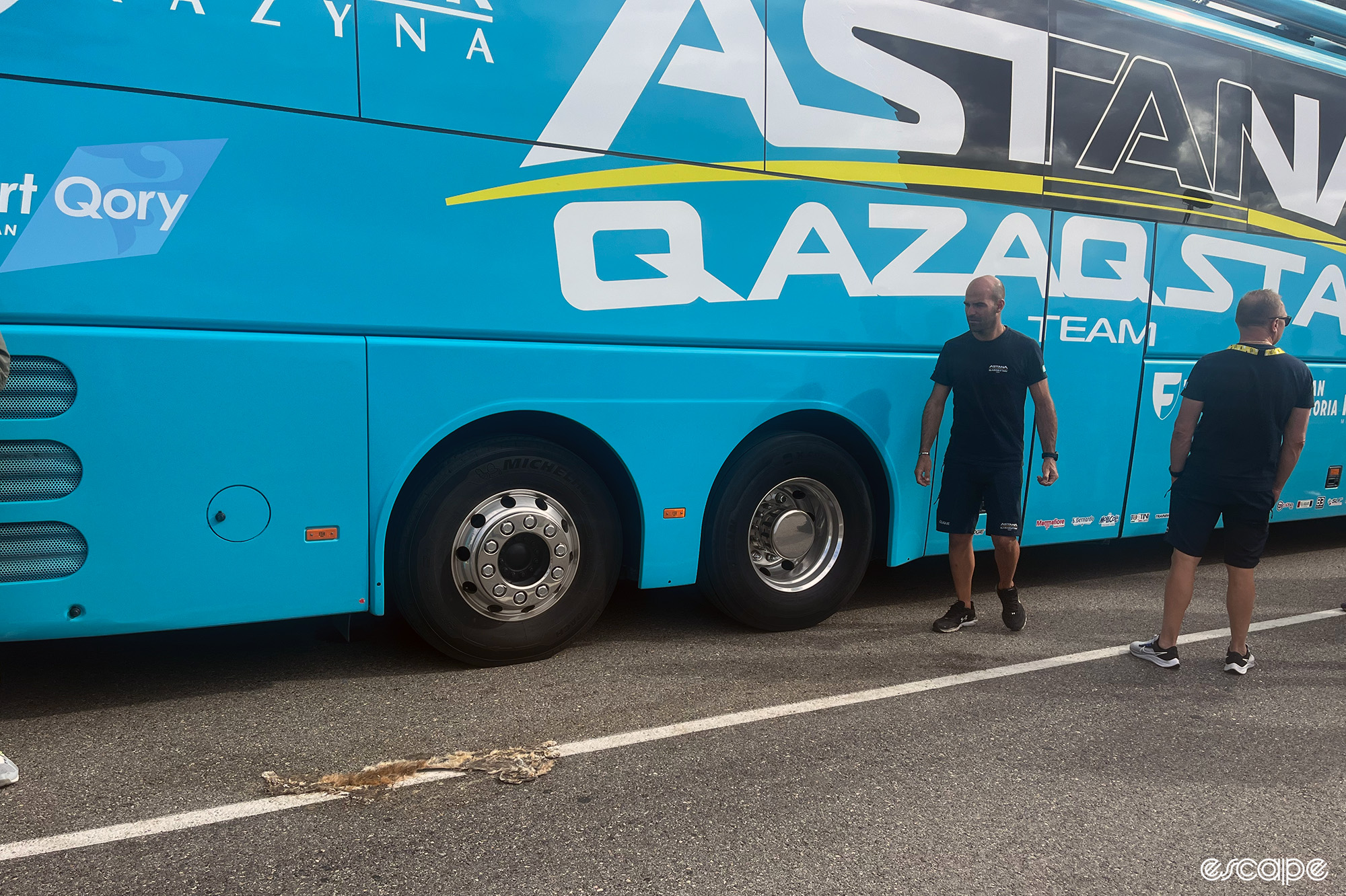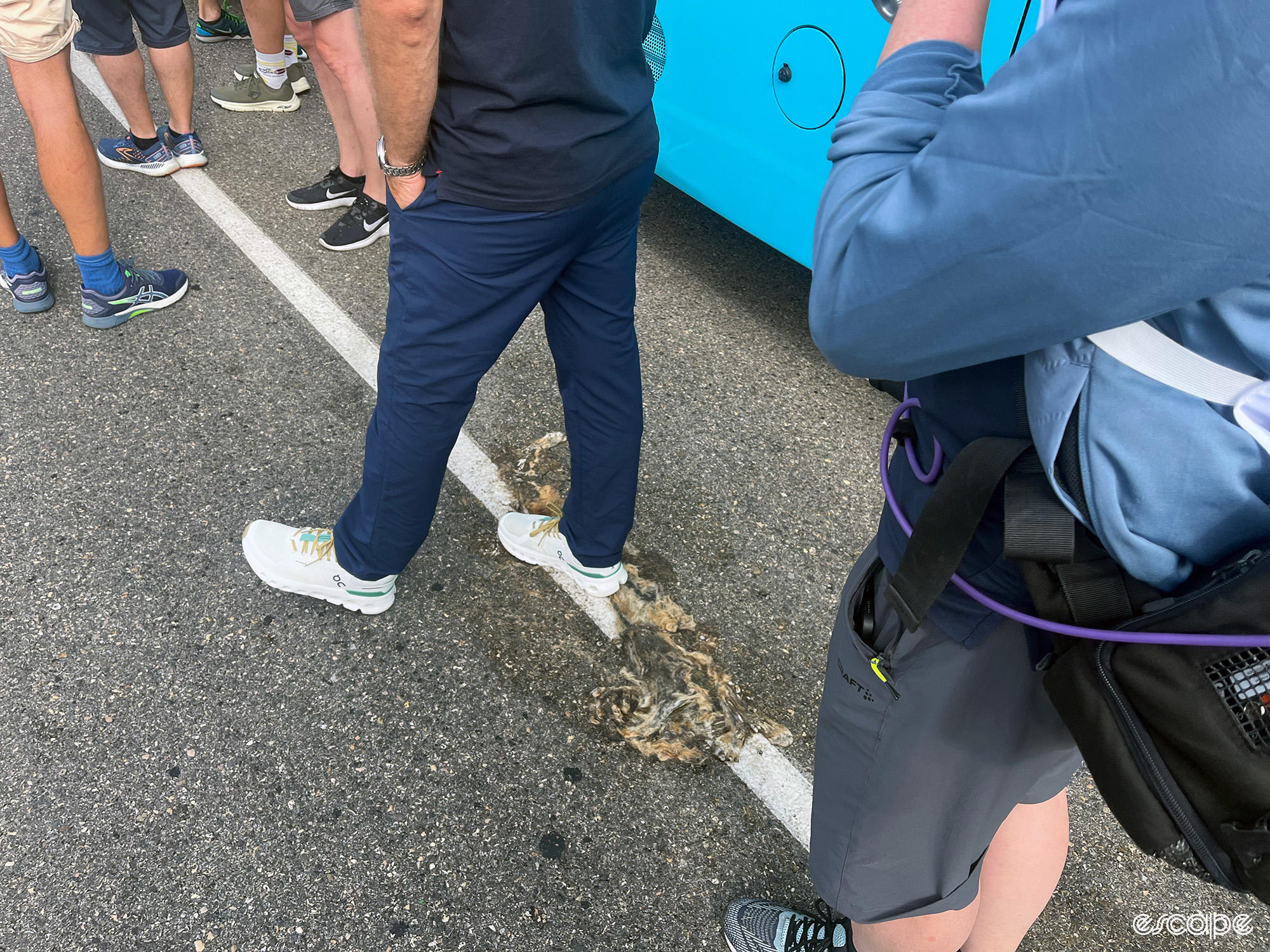I'll begin with two caveats. Firstly, there is other content on our website more appropriate for Mark Cavendish's record-breaking day. Dane has the GIFs breaking down the sprint, Kate has the, well, Kate.
Secondly, roadkill is a part of modern life, for better and worse. One day everything you've ever known and loved will no longer exist anymore, and we can't do anything about it. Fortunately, if you're reading this, that's not the case for you. Unfortunately, for the fox smushed deep into the tarmac next to the Astana Qazaqstan team bus, its time on this Earth is very much over.
Our intent is not simply to be callous, but the facts of the matter are that the bus given the most attention at the end of the Tour's stage 5 was also the one that had quite a gross smushed fox carcass directly outside of it. This is a newsworthy, historic day. Our solemn duty as Very Serious Journalists is to provide an account of the events as a ledger of record.
Maybe you think this too vulgar, too gross, too irrelevant to cover. If so, apologies, but our Chief Dead Animals In Public Correspondent Iain Treloar doesn't arrive at the Tour until tomorrow, so for the time being I'm trying my best to fill his shoes (shoes that will be fumigated upon his return to Australia).
So what do we know about the fox? It's easier to start with the things we don't know: its name, how it got squished, how long it has been squished for.

The story begins with Caley and I running from the Visma-Lease a Bike bus, positioned at one end of the 750 metre road where the buses were all parked, to the other side where Astana Qazaqstan were posted up.
Arriving at the back of the scrum, we listen to Alexey Lutsenko give his view of this historic day. Once he's finished speaking, Caley leans and says quietly: "What's that smell?"
In these scrums, to pull back the veil, there are often gentlemen of the media with less-than-perfect hygiene. They may have been running around all day and therefore be covered in a thin film of sweat and dirt, they may have an every-other-day approach to showering. Either way, it's not uncommon to be greeted by unwelcome wafts while trying to grab quotes from riders.
Indeed, the smell was pungent. More pungent than usual. And it wasn't going away despite the temporary dispersal of the crowd as Lutsenko made his way onto the bus. Caley turned around and repeated the question to a colleague (one with impeccable hygiene), who replied that the smell is a dead fox.
We chuckle, a moment of levity within the earnestness of history being made. But no, they insisted, it is actually a dead animal, pointing to the floor beyond the feet of the international media next to us. Laying on top of the asphalt was the rotting carcass of a once-precious creature, and only some people seem to have noticed, stepping around it gingerly, doing their best to pretend it's not there and continuing on with their day as normal.
Others were not so observant.
Cavendish's coach, Vasilis Anastopoulos, has understandably not noticed, holding back tears during a moment years in the making finally coming together. He is standing directly in the fox as he gives a reporter insight into just how his rider's feat was possible.

Bound by the unwritten code that every journalist signs up to when answering the call of holding truth to power and/or investigating roadkill caught up in the bedlam of seismic sporting events, I approached the fox apprehensively, to really see and observe it.
It still smelled hot and sweet, having been baking in the afternoon's sun once the clouds had cleared, with a hint of wet dog in there as well. With fur and some other bits positioned a few metres down from the main carcass, a crash scene reconstruction would likely show the animal being dragged slightly as it met its grisly end. At this point, already slightly cracked a week since landing in Florence for the Grand Départ, I questioned the sense, tastelessness and morals of what I was doing.
A colleague, who's name doesn't deserve to be caught up in this, sidled up to me: "It's been dead a while, but somehow still stinks," they said.
A few other questions also remain.
Did Mark Cavendish, after completing podium duties, doping control and press conference, see the fox as he greeted his support staff and teammates? What did he make of it? Did he smell the fox? Did it take the shine off of number 35? What would the fox make of Sir Mark Cavendish's record-breaking feat? Did the fox once believe in the British honours system, and to a greater extent the idea of a constitutional monarchy?
More cerebrally, is there anything to be learned from this dead fox? A fox that just so happened to have met its sudden end exactly where the most popular bus of the day for the stage finish outside the town Saint-Vulbas would roll up. I mean, what are the chances, out of 22 buses? Now gone are potential timelines of Jonas Vingegaard shuddering in horror at the cruel reality of a world that would see a defenceless creature brought to such an end, of David Gaudu being put off his post-stage snog by the wafts of death, of Marc Madiot wrinkling his nose at the animal that dared to ruin the perfect French vibes of yet another otherwise delightful day at his Grand Tour.
No, there is probably nothing to be learned. Some things are just there to be experienced. A minor footnote on one of the biggest days for our sport. We'll all remember it as the day Cavendish broke the record and my second thought will always be the dead fox smashed into the asphalt at the side of his team bus.
Did we do a good job with this story?



